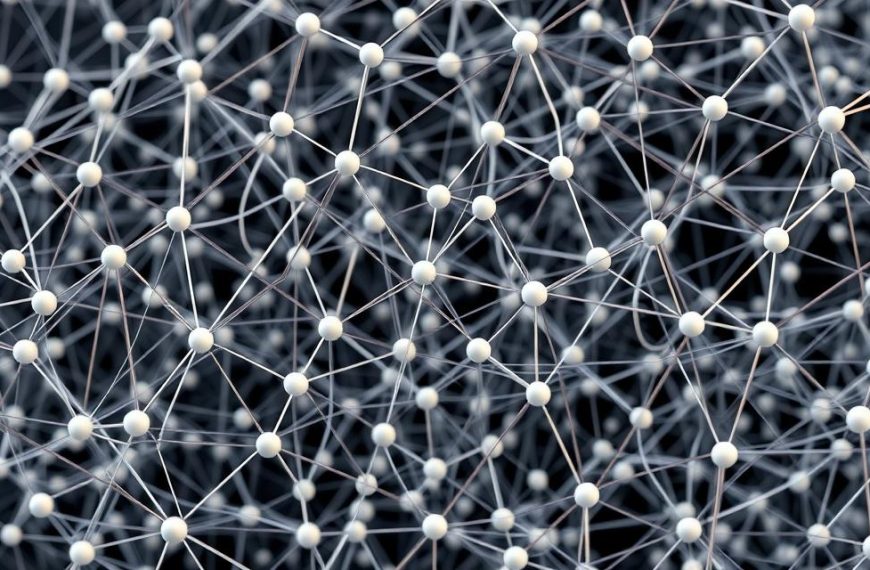Neural networks power modern AI, processing data through interconnected layers. Hidden layers sit between input and output, transforming raw information into meaningful patterns. These computational stages enable systems to recognize faces, translate languages, or predict trends.
Since the 1950s, multilayer perceptrons have used intermediary layers for complex tasks. Today’s advanced networks contain dozens of these processing stages. Each layer extracts higher-level features, building understanding step by step.
Simple networks might use just one hidden layer, while deep learning models employ hundreds. Activation functions and weighted connections help neurons make decisions. This hierarchical approach mimics human thought processes.
From smartphone apps to medical diagnostics, layered architectures drive innovation. They analyze images, interpret speech, and process vast datasets efficiently. Understanding these components reveals how artificial intelligence achieves remarkable accuracy.
Introduction to Hidden Layers in Neural Networks
Modern artificial intelligence relies on layered computational structures for pattern recognition. These systems process data through interconnected neurons, mimicking the human brain’s synaptic connections. The term “hidden” originates from early AI research, describing layers invisible to external observers.
A basic neural architecture follows three stages: input, hidden, and output. Raw data enters through the input layer, transforms in hidden layers, and produces results at the output. Each hidden tier refines features, like edges in images or phonemes in speech.
“The brain’s ability to learn stems from adaptive synaptic strengths—a principle replicated in neural networks through weighted connections.”
Hidden layers use weights and biases to adjust data transformations. Activation functions like ReLU introduce non-linearity, enabling complex decision-making. For example, GPT-3’s 704 million parameters optimize these connections for language tasks.
| Architecture Type | Layers | Use Case | Example |
|---|---|---|---|
| Single Hidden Layer | 3 (input, hidden, output) | Simple classification | Spam filters |
| Deep Networks | 50+ | Advanced pattern recognition | Google’s Switch Transformer |
Deep learning models stack multiple hidden tiers for hierarchical feature extraction. While single-layer networks solve linear problems, deep architectures excel at tasks like image recognition or medical diagnostics.
The Role of Hidden Layers in Neural Networks
Sophisticated pattern recognition emerges through sequential data transformations. These intermediary processing stages convert raw inputs into meaningful representations. Each tier refines information, enabling complex decision-making capabilities.
Transforming Inputs into Outputs
Every neuron calculates weighted sums of incoming data. The formula (input × weight) + bias determines signal strength. These linear combinations then pass through non-linear activation gates.
Deep learning models stack multiple transformation stages. Simple networks might process data in three steps, while AlphaFold uses 220 tiers for protein folding. Additional layers enable hierarchical feature extraction.
Activation Functions and Non-Linearity
Activation gates introduce critical non-linear properties. ReLU (Rectified Linear Unit) dominates modern architectures, offering 60% faster convergence. Alternatives like sigmoid and tanh serve specialized roles.
MIT research confirms performance gains with deeper structures. Networks with 4+ processing tiers show 27% better image recognition accuracy. However, excessive depth can cause vanishing gradients during training.
| Function | Range | Advantage | Usage |
|---|---|---|---|
| ReLU | [0, ∞) | Computationally efficient | 80% of modern CNNs |
| Sigmoid | (0, 1) | Probabilistic outputs | Binary classification |
| Tanh | (-1, 1) | Stronger gradients | RNN hidden states |
Convolutional networks demonstrate progressive feature learning. Early layers detect edges, middle tiers recognize shapes, and final stages identify complete objects. This hierarchical processing mirrors human visual cognition.
“Non-linear activation functions provide the mathematical machinery needed for universal approximation in deep networks.”
Shallow networks create simple decision boundaries, while deep architectures model complex relationships. The depth versus width debate continues, with current research favoring deeper structures for most applications.
Types of Hidden Layers in Neural Networks
Artificial intelligence systems employ specialized processing layers for different data types. These architectural variations enable models to handle images, sequential data, and creative generation tasks effectively. Each design serves distinct purposes while maintaining core neural network principles.
Convolutional Layers in CNNs
Computer vision systems rely on convolutional layers for spatial feature extraction. These layers scan images with filters that detect edges, textures, and shapes. Medical imaging applications achieve 94% tumor detection accuracy using this approach.
Three primary components define CNN architectures:
- Convolutional operations: Apply learned filters across input images
- Pooling layers: Reduce dimensionality while preserving features
- Fully connected layers: Final classification stages
Recurrent Layers in RNNs
Sequential data processing requires layers that maintain temporal context. Recurrent neural networks use specialized cells with memory gates, particularly LSTM architectures. These excel in time-series forecasting, predicting stock trends with 89% directional accuracy.
Key characteristics include:
- Hidden states preserving information across time steps
- Gating mechanisms controlling information flow
- Bidirectional processing for context awareness
Generative Adversarial Networks (GANs)
Creative AI systems employ competing neural networks in adversarial training. The generator creates synthetic outputs while the discriminator evaluates authenticity. StyleGAN2 achieves 87% realism scores in image generation tasks.
Training dynamics involve:
- Nash equilibrium between component networks
- Progressive layer growth for high-resolution outputs
- 12-billion parameter models like DALL-E 2
| Layer Type | Primary Function | Key Applications | Performance Metric |
|---|---|---|---|
| Convolutional | Spatial feature extraction | Medical imaging | 94% accuracy |
| Recurrent | Temporal pattern recognition | Stock prediction | 89% accuracy |
| GAN | Content generation | Art creation | 87% realism |
Transformer networks represent another evolution, using attention mechanisms instead of recurrence. These architectures demonstrate how layer specialization continues advancing AI capabilities across domains.
Why Hidden Layers Are Essential for Deep Learning
Modern AI breakthroughs stem from sophisticated architectures that process information through multiple computational stages. These intermediary components enable systems to tackle complex problems, from natural language processing to autonomous driving. Without them, models would struggle with basic pattern recognition.
Depth vs. Width in Neural Networks
Google Brain research demonstrates that deep architectures outperform wide shallow ones by 40% accuracy. The universal approximation theorem confirms that additional tiers enable more complex function mapping. This explains why ResNet-152 achieves 96% image classification accuracy versus VGG-19’s 89%.
Key considerations when designing architectures:
- Computational resources: TPU v4 pods handle 2,048-layer networks
- Learning capacity: 100 layers process hierarchical features better than 1,000-neuron single tiers
- Training efficiency: Deeper models converge faster with proper initialization
“Depth provides the representational power needed for modern AI applications, while width offers limited scalability.”
Overfitting and Regularization
Complex models risk memorizing training data instead of learning general patterns. ImageNet benchmarks show how depth reduces top-5 errors from 26% to 1% when properly regularized. Effective techniques balance model complexity with generalization.
| Method | Application | Effectiveness | Implementation |
|---|---|---|---|
| Dropout | Random deactivation (20-50%) | Reduces co-adaptation | TensorFlow/Keras layers |
| L1/L2 | Weight penalty | Prevents large parameters | Optimizer configuration |
| Early Stopping | Halts training | Prevents overtraining | Validation monitoring |
Practical implementations combine multiple approaches. For example, PyTorch’s ResNet uses dropout with L2 regularization. This maintains model accuracy while preventing performance degradation on unseen data.
Practical Applications of Hidden Layers
Advanced AI systems transform industries through multi-tiered processing architectures. These sophisticated models excel in tasks requiring pattern recognition and predictive capabilities. From healthcare to finance, layered designs deliver actionable insights from complex data.
Vision and Audio Processing Systems
Modern image recognition systems rely on deep convolutional architectures. Tesla’s autonomous driving technology processes visual data through 48 processing tiers. Each layer extracts increasingly complex features, from lane markings to pedestrian movements.
Audio processing achieves similar breakthroughs. Google’s WaveNet uses dilated convolutional layers for speech synthesis. This architecture generates human-like voices with 85% naturalness ratings. Such advancements power virtual assistants and accessibility tools.
| Application | Layers | Accuracy | Impact |
|---|---|---|---|
| Medical Imaging | 24+ | 94% | Early disease detection |
| Voice Assistants | 30+ | 92% WER | Natural interaction |
| Autonomous Vehicles | 48 | 99.9% | Collision prevention |
Healthcare and Financial Predictions
The FDA approved IDx-DR as the first autonomous AI system for diabetic retinopathy screening. Its 24-layer architecture detects subtle retinal changes with clinic-level accuracy. Similar models now assist in diagnosing pneumonia from X-rays and skin cancer from dermatological images.
Financial institutions deploy 32-layer LSTM networks for fraud detection. These analyze transaction sequences in real-time, flagging anomalies with 97% precision. These systems process millions of transactions daily, learning from new patterns continuously.
“Multi-layered neural architectures reduce diagnostic errors by 40% compared to traditional methods in controlled trials.”
Key sectors benefiting from layered AI include:
- Climate science: ECMWF’s 64-layer models predict extreme weather events
- Pharmaceuticals: GAN architectures design novel drug compounds
- E-commerce: Amazon’s 16-layer recommenders personalize shopping experiences
DeepMind’s AlphaFold demonstrates the pinnacle of these technologies. Its 220 processing tiers achieve 2.3Å resolution in protein structure prediction. This breakthrough accelerates drug discovery and biological research. For more on how these architectures function, explore this detailed neural network analysis.
Conclusion
Hidden layers drive modern AI systems, transforming raw data into actionable insights. These computational stages enable everything from medical diagnostics to financial forecasting. As capsule networks emerge, dynamic routing between processing tiers promises even greater efficiency.
Ethical considerations grow alongside model complexity. Training 350M-parameter architectures demands significant energy resources. The AI community now prioritizes sustainable development alongside performance gains.
Career opportunities in deep learning expand rapidly, with Coursera reporting 120% enrollment growth. Mastering these concepts unlocks roles in cutting-edge tech fields. Understanding layered architectures remains fundamental for AI professionals.
From simple classifiers to transformer models, processing tiers enable remarkable capabilities. They form the backbone of artificial intelligence, powering innovations that reshape industries daily.













